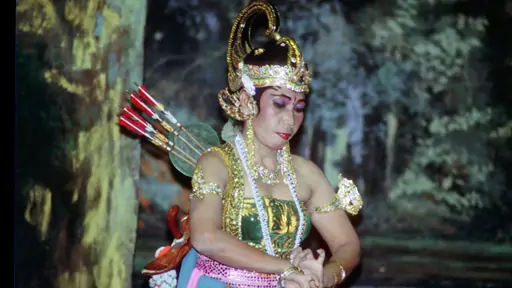Indigenous Calendar June, 2011: Sita in "The Ramayana" in Indonesia

The Indonesian island of Java is steeped in legend, tradition and culture. In my three weeks on that island I saw everything from traditional music performances to silversmithing, jewelry making, puppet making and exquisite, hand-made furniture.
We hear often today that Indonesia is the most populous Moslem nation in the world. While that is a true statement, Java, in particular, has a wealth of still-practiced religious heritages — from Animism to Christianity. One of the legacies of the spread of Hinduism throughout the island is the practice of Hindu tradition. And one of the most spectacular ways to witness it is to attend a theatrical performance of Maharshi Valmiki's epic story, The Ramayana. Originating in India and telling the ubiquitous tale of kings and queens, war and peace, love and hate and ultimately tragedy, the story focuses on Shri Rama and his wife Sita. But The Ramayana goes beyond traditional story telling. It is primarily a teaching of original Hindu philosophy.
A performance of the complete story can last many hours. I was in a small town where the nightly performance was of the cut-down version: it only lasted about three hours.
I arrived an hour before the start of the performance so I could consider camera angles and positions. When the cost of the ticket turned out to be only about 75 US cents I wondered whether all but the nose-bleed seats were sold out (not a problem because it was a relatively small amphitheater), or the production was amateur and likely not to be very good or even worth staying the whole three hours.
About half an hour before the show was due to start a mainly gamelen orchestra started up. I wasn't sure if they were tuning or just practicing but the music sounded haunting and ethereal. It was the perfect mood setter for the build up to the actual performance. As I recall it was a Tuesday night when I attended the performance. Even so the audience was very small — perhaps two hundred people in an amphitheater capable of seating five or six hundred. This also led me to question what the quality of the performance might be like. I'd prepared by reading a few basic synopses of the story and, although I knew it would make for good drama, only a high-quality production was going to hold my attention for three hours.
My concerns were ill-founded. A seat as close as mine was to a stage where this level of drama was being enacted so professionally would have cost at least 75 dollars in the United States — and I wouldn't have been allowed to wander around at my leisure taking photos. In fact I got so caught up in the performance I only shot two rolls of film in the whole three hours.
Everyone has their favorite character in The Ramayana. Many identify with the hero-monkey, Hanuman. But for photography none was more captivating than this lady's portrayal of the heroine, Sita.
If you enjoyed reading this article, please consider supporting independent, advertising-free journalism by buying us a coffee to help us cover the cost of hosting our web site. Please click on the link or scan the QR code. Thanks!


